Contents
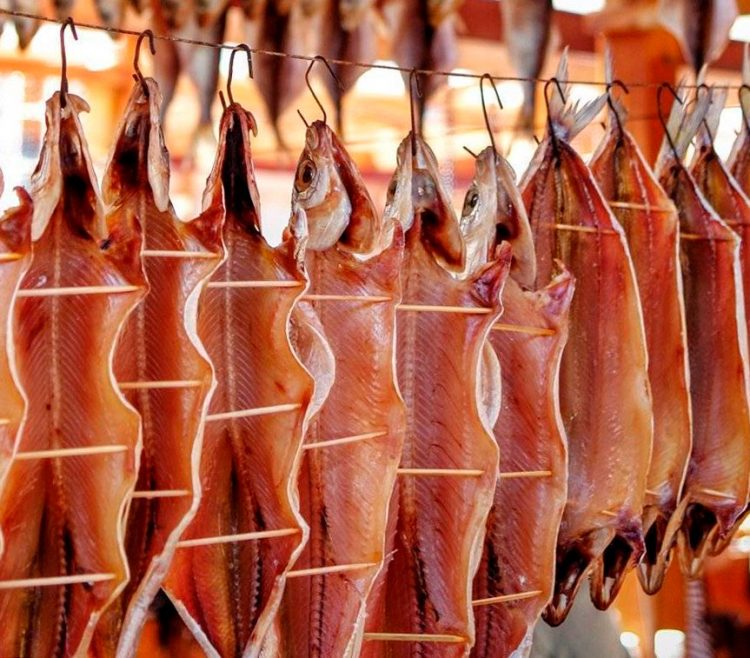
Dried fish is considered a tasty and healthy food product for humans. Drying technology does not provide for the processing of fish at elevated temperatures. The process is carried out in a natural environment.
Such fish is also called dried, because its meat is dense and dry. Fish prepared using this technology is stored for a long time without special storage conditions.
Dried fish is a great appetizer that can be served at the dinner table. In addition, such fish can help out on a trip, as it will not deteriorate.
What is wilting?
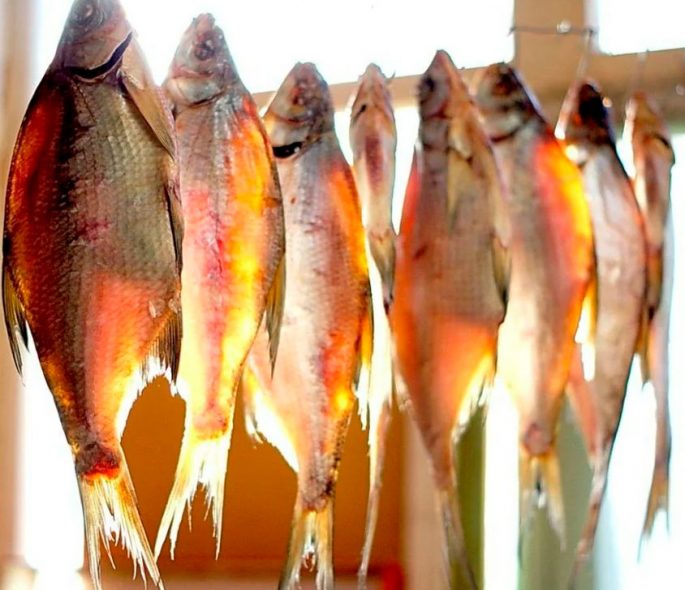
Dried fish is a product that is cooked in natural conditions, but before this process, the fish must be salted.
Interesting to know! The drying process is characterized by the fact that as a result, the fish acquires completely different properties and an interesting attractive taste appears in it. This technology is also called drying.
As a result of slow processes, the meat is dehydrated, and the influence of the environment helps the meat to ripen. As a result:
- The meat is saturated with fat, becoming dense and elastic.
- The meat takes on a translucent appearance, with a beautiful amber hue.
- If the fish is caviar, then the caviar becomes a delicious grainy delicacy.
The aroma of dried fish cannot be confused with any other aroma. The meat is eaten after the skin is removed from the fish along with the scales.
How to Salt and Dry FISH. Dried fish. An easy way to salt rams
What kind of fish can be dried?

It is important to know which varieties of fish in the process of this cooking technology can please with excellent results.
Not all varieties of fish are suitable for the curing process, as the meat of some fish does not ripen properly, so it is impossible to get the correct structure from it, as well as the aroma that is characteristic of dried meat.
Small varieties of fish that are not considered valuable have similar positive characteristics. These types of fish include roach, ram, sabrefish, silver bream, etc., which belong to the so-called partial. Larger species of fish, such as bream, pike perch, catfish, etc., can also be used for drying.
If you salt fresh fish caught on the day of fishing, you will get the highest quality end product as a result. It must be remembered that the fish deteriorates quickly enough. Drying fish with a “smell” is practiced by indigenous northern peoples, but this technology is not suitable for familiar people. It is possible to dry fish after defrosting, but this product will not meet all the necessary characteristics. Sometimes the catch is frozen and then thawed and dried, but this is only a last resort.
To make the fish tasty, it is better to dry the fish of medium and high fat content. The quality of the original product also depends on when the fish is caught – in winter, spring, summer or autumn. Preference should be given to fish caught in winter or early spring before the spawning process, since during these periods the fish have the largest reserves of fat.
Preparing fish for drying
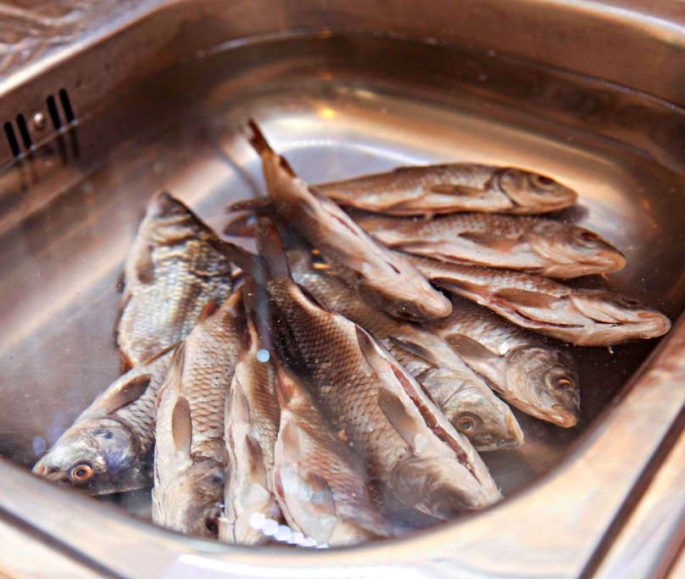
Before salting the fish, it is recommended to rinse it and also clean it of mucus, although some fishermen believe that this can negatively affect the taste of the fish, so they only remove the dirt with a cloth.
In no case should you peel off the scales, and it is better not to gut smaller fish, since the fat of the peritoneum and the insides of the fish give the product a brighter taste.
In the summer, when the contents of the stomach of herbivorous fish species quickly deteriorate, such fish must be gutted, otherwise bitterness may appear in the fish.
If you plan to dry a large fish, then it must be cut completely. The insides of the fish are removed, but the skin with scales should not be touched. The belly is also not touched, since it contains a lot of fat, which is necessary for the curing process. To extract the insides, it is best to make an incision along the dorsal fin. After such cutting, the carcass of the fish does not need to be washed.
How to dry fish in the summer at home: cooking steps
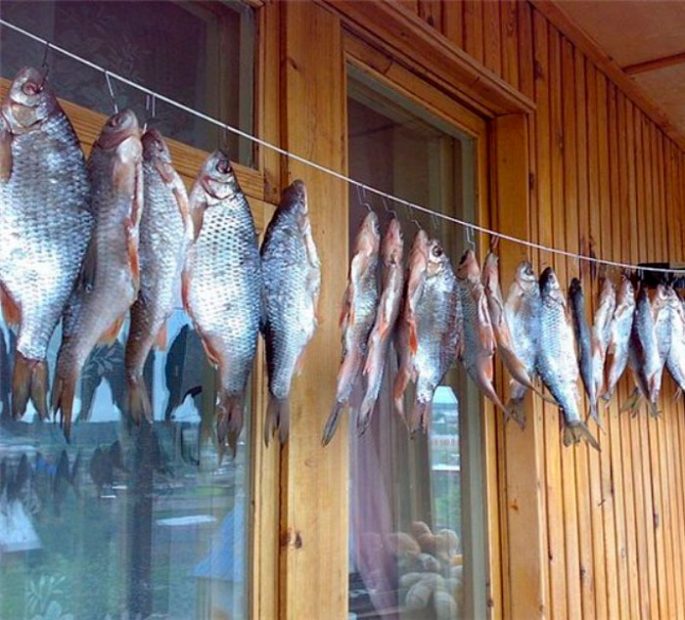
The drying process is characterized by the presence of certain stages, which are carried out in the right order. So:
- Salting fish. Any container is suitable for this, but not metal. The fish is sprinkled with salt, and then filled with saline. After that, the fish is placed in a cold place.
- Washing and soaking fish. Washing and then soaking is carried out in fresh water. The duration of the process depends on the duration of salting.
- Drying process (drying). It is carried out in natural conditions, although any devices can be used.
How to dry fish at home
Summer salting methods
For the salting process, you only need salt and a container. It is better not to use dishes for non-food products. The most important thing is that its volume allows you to pickle the right amount of fish. It is better to take coarse salt, which dissolves slowly, taking excess moisture from the fish. Fine salt speeds up the salting process without dehydrating the fish.
Dry Ambassador
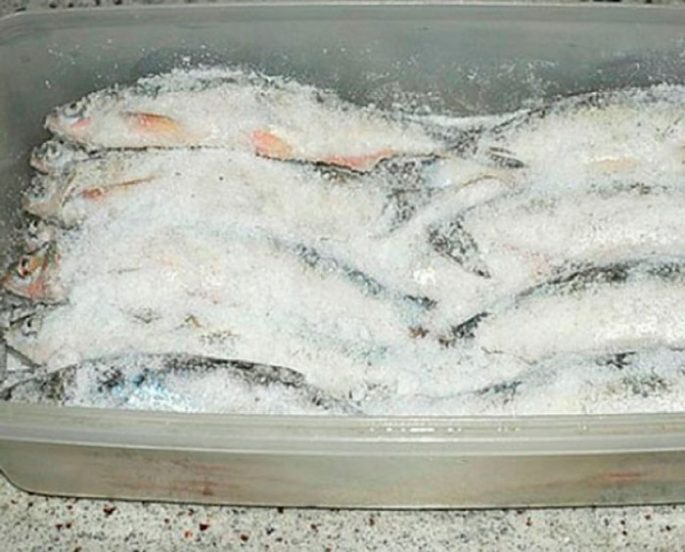
This method of salting is more suitable for drying carcasses weighing 1 kilogram or more.
The technology is as follows:
- The carcass of the fish is freed from the insides by making an incision along the back, after which the fish is cleaned with a rag.
- The fish inside is salted abundantly, but not very much.
- Carcasses of fish are placed in rows in containers, while a cloth should be placed on the bottom of the container. The fish is laid out head to tail and bellies up.
- After that, the fish is salted again. For 10 kilograms of fish, up to one and a half kilograms of salt will be required.
After the salting process, the fish is covered tightly with a lid, while a heavy object (oppression) is placed on top of the lid.
On a note! The presence of oppression allows you to prevent the appearance of air bubbles in which harmful bacteria can develop. As a result of the acting pressure, the density of the meat increases.
The fish is salted for 5-10 days. In the process of salting, juice is released, which must drain through the slots at the bottom of the container. In this regard, the process was called “dry” salting.
If small fish are salted, then the insides can not be removed from it. In this case, a small fish is laid out tightly one to one on the fabric, after which it is sprinkled with salt and wrapped in the same fabric. Above you need to put a load. The juice that appears as a result of salting flows out through the fabric.
Wet method
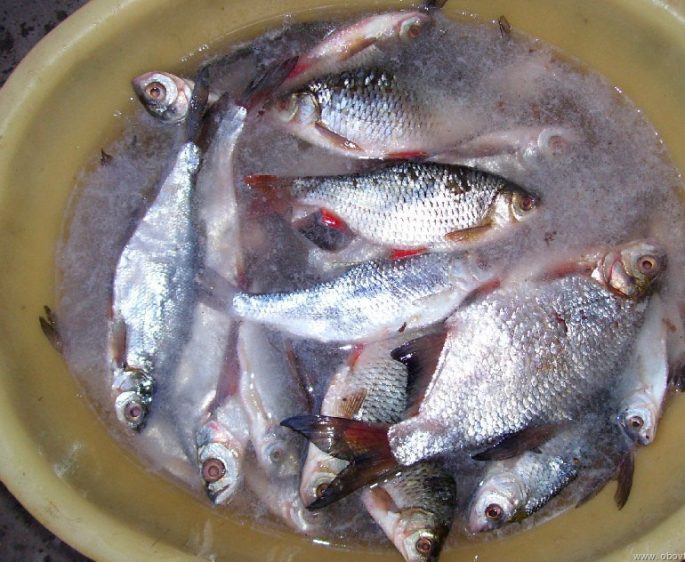
If the fish is small, then it is better to use the wet method. Fish such as roach, perch or bream are salted in the following way:
- First you need to take the dishes and pour salt on its bottom, then the fish fits into this dish quite tightly.
- Having laid out the first layer, the fish is sprinkled with salt, after which the subsequent layers are laid out with salt pouring each layer, including the top layer. For 10 kilograms of fish, about 1 kg of salt is required.
- If you add at least one tablespoon of sugar to the salt, then the taste will be more refined.
- All fish is pressed with the help of oppression (load).
In the process of salting, juice appears, and there is so much juice that it can flow out over the edge of the container (unless, of course, the fish is full of capacity). For the time of salting, the fish is placed in a cool place, otherwise the fish may deteriorate without being fully cooked.
When salting at home, the fish is placed in the refrigerator, and when salting on a hike, you should dig a hole in the ground, covering it with branches. If the fish is not large, then it is enough to hold it for a couple of days, and if the carcasses are large, then they will have to be kept in salt for about a week. The fish can be considered ready if its meat becomes hard, and if you pull it by the head, you can hear a characteristic crunch. If, as a result of the check, these characteristics are not confirmed, then the fish is left in brine for another day. The brine after salting can be reused, and if it is no longer needed, then it is poured out.
Tuzluchny way
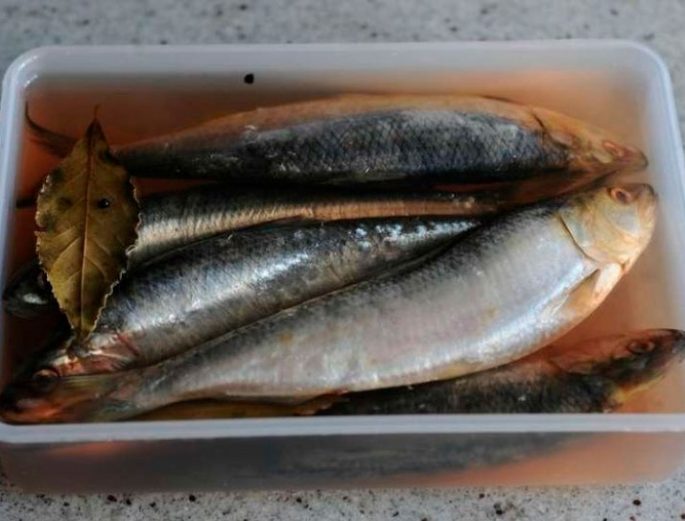
Before salting, the fish is strung on a rope with a needle. In such a collected state, the fish sinks for several days, depending on the size, into the brine – brine. It is enough for small fish to lie down in the brine for 2-3 days, and if the fish are large, then a salt solution is additionally pumped into their carcasses using a syringe
A salt solution is prepared at the rate of 350 g of salt per 1 liter of water. You can combine freshly prepared brine with the brine of the previous salting or with the brine of purchased spicy salted herring.
Important rule! If you prepare the brine solution correctly, then a raw egg should not sink in it.
The larger the fish, the longer it should be in the salt solution. At a temperature of 20 degrees, the fish is salted:
- Within a week, the fish is salted if its weight is more than 1 kilogram.
- If carcasses weigh no more than 0,5 kilograms, then it will take about 2-3 days.
- A small fish like a sprat is salted for 1 hour.
The readiness of the fish is determined by longitudinal stretching. If you pull the fish by the head, you should hear a sound in the form of a crunch. In the absence of a crunch, the fish is not yet ready, since the salt has not penetrated to the vertebrae. Well-salted fish does not resist finger pressure. If you press on the back of the fish, then a hole should remain.
When the fish is properly cooked in the brine, it is pulled out of the brine and left to rest for several hours. As a result, the salt will be evenly distributed in the fish meat, which will lead to a quality result.
HOW TO DRY FISH AT HOME
Soaking
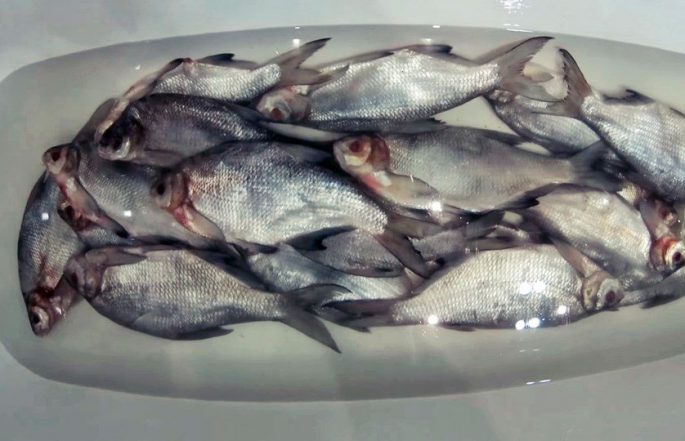
The soaking process is considered no less responsible, since it is intended to get rid of the saltiness of the outer surface of the meat. Desalination of the upper layers leads to the fact that the dried skin does not absorb moisture during storage, and this increases the shelf life of the product. The duration of soaking depends on the duration of salting: every day, salting requires 1 hour of soaking.
Washing the fish from dirt and salt is part of the soaking process. The fish is washed carefully by hand. It is necessary to ensure that the scales do not fly off, which serves as protection for internal tissues.
The fish is soaked in a large container with cold water. After a while, the fish begins to float to the surface, which indicates the result achieved. After drying, it will turn out to be slightly salted, and its meat will acquire a transparent amber hue.
Too long a soaking process can spoil, especially fatty large fish. As a result of a long stay in the water, the outer layer soaks. In this case, it is recommended to soak in several approaches, taking out the fish for as long as it has been in the water.
Drying rules in various conditions
As a result of many years of drying experience, it has been established that the fish is cooked most correctly if it is strung on a wire or on a cord. Low-fat varieties of fish are best hung up by stringing it on a string head down. It is better to dry fish such as bream or pike perch, placing them head up, stringing them on a rope, pulling it through the eyes. This is necessary so that the fat cannot leak out of the abdomen. Alternatively, it is permissible to use other devices in the form of hooks, nails or thin rods.
Outdoors
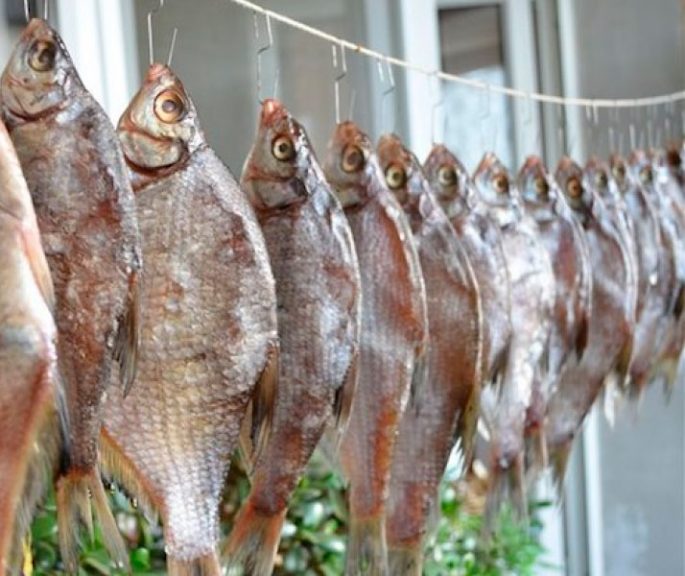
The tastiest fish is the one that is dried in the right weather in the open air. As a rule, this is a spring day, with air temperature in the range of 18-20 degrees. The fish is hung with the help of any devices.
An important point! It is desirable that the fish are loosely adjacent to each other, and their abdomens are located outward. If the fish is small enough, like a sprat, then it is better to dry it on a horizontally stretched net.
If the fish is placed in the sun, especially in hot weather, then it will either “cook” or begin to disappear before it dries. In addition, a valuable product, fat, will flow out of the fish. The ideal drying process is carried out in the shade or under a canopy. If the outdoors is too humid, then it is better to bring the fish indoors.
In a cool cellar
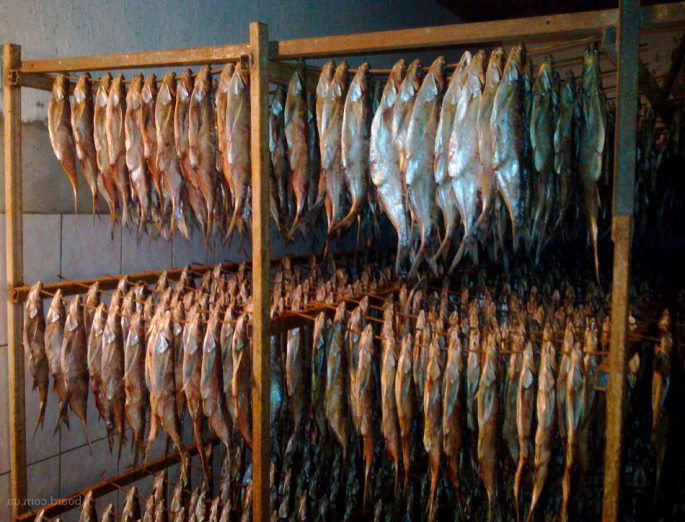
If a person lives in a private house, then he must have a cellar, which is a great place for salting fish. In addition, smaller fish can be dried in the cellar, although then it is dried in a warmer place.
As for large fish, when dried under normal conditions, bitterness may appear in it, but this will not happen when dried in the cellar, although this may take up to 3 weeks. Fish dried in the cellar is characterized by the best taste data.
On the balcony and loggia
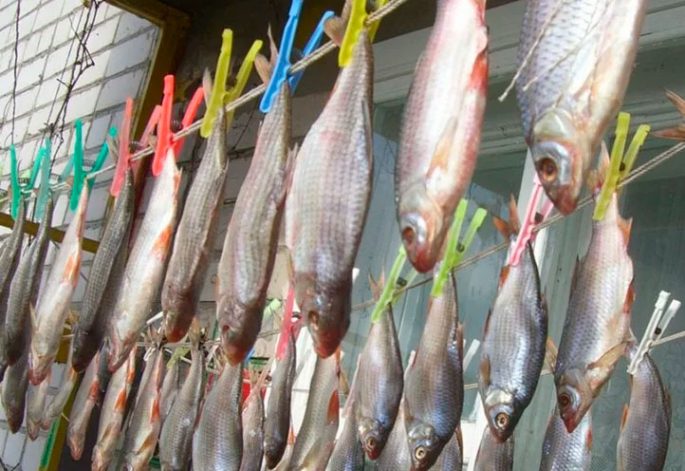
A balcony or loggia, if they are glazed and have opening parts for ventilation, are also suitable for drying fish. Here the fish is protected from both rain and cold. The main thing is to hang the fish so that the resulting fat does not drip onto the floor. As an option, a basin or other container is installed under the fish.
The best option is when the fish is dried in a draft, so the balcony or loggia can be opened even when it’s cold outside.
Drying in the attic
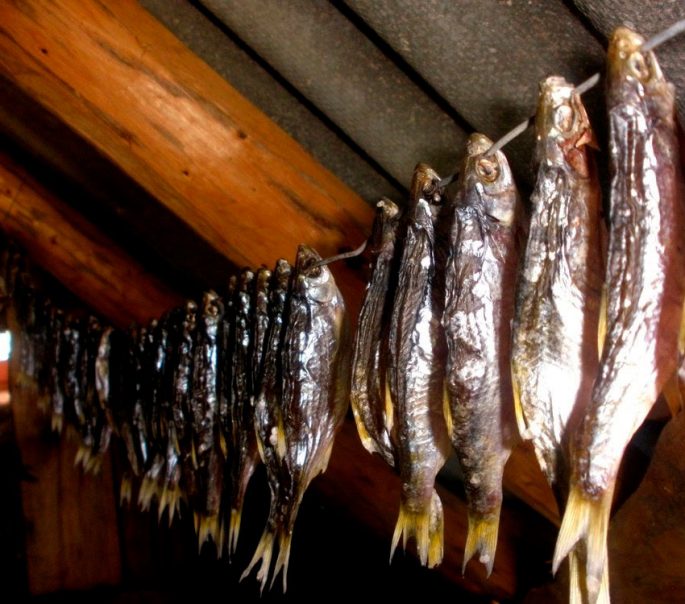
As a rule, the attic is a well-ventilated room, if it does not house living or utility rooms. The attic is heated through the roof, but remains cool due to the presence of drafts. Here the fish is reliably protected from direct sunlight and from precipitation. The main thing is to make sure that the cats do not get the fish.
Drying in living quarters
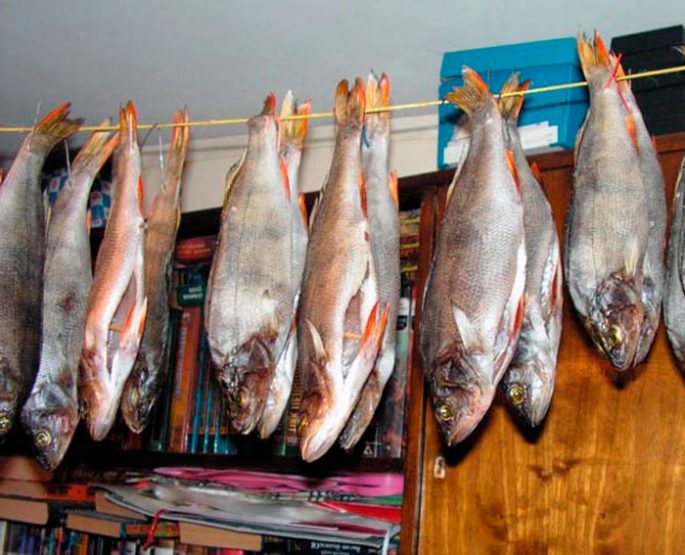
There are cases when, in the absence of other options, it is necessary to dry the fish in the room, although the room will inevitably be filled with a specific fishy smell that many do not like. Although such a product is noticeably inferior in quality to that dried in the open, its palatability remains at an acceptable level. This process can be accelerated by using various heating devices.
On a note! The process is noticeably accelerated if you use a fan. If there are few fish, then it is quite possible to place it within the limits of a gas stove.
In an electric dryer

To dry the fish, you can arm yourself with any type of electric dryer that operates on the convection principle, while the heating must be regulated. Do not set the temperature above 30 degrees, as the fish meat will begin to fall off the bones.
Drying is provided by the operation of the fan. Drying time is about 2 days. Naturally, a fishy smell will be present in a person’s home, but the quality of the product will be acceptable.
Dried Fish in Astrakhan. How to dry, salt, dry fish. Roach, Perch, Ram
How long to dry and how to determine readiness?

The process of drying fish depends on both the air temperature and its humidity, including the size of the carcasses. A small fish can be ready in a couple of days, although in reality this process stretches for one or two weeks. As for large fish, it can dry for a month.
The fish should not be overdried, but it is better not to dry it out a little, determining its readiness to taste.
If the meat is not dry enough, then the fish can be left for a while.
- Cured meat is quite transparent, while it is dense and elastic, with a sheen of fat.
- There are no signs of salt on the surface of the fish, while the skin is strong and easily removed.
- Such fish has a pleasant aroma that causes appetite.
After drying, the fish can be eaten immediately, but the full maturation of the meat is possible only after 3-4 weeks. To do this, the fish is wrapped in cloth or parchment, after which it is placed in a cool place. After lying in this state, the fish finally acquires its qualities of a full-fledged food product.
How to get rid of flies
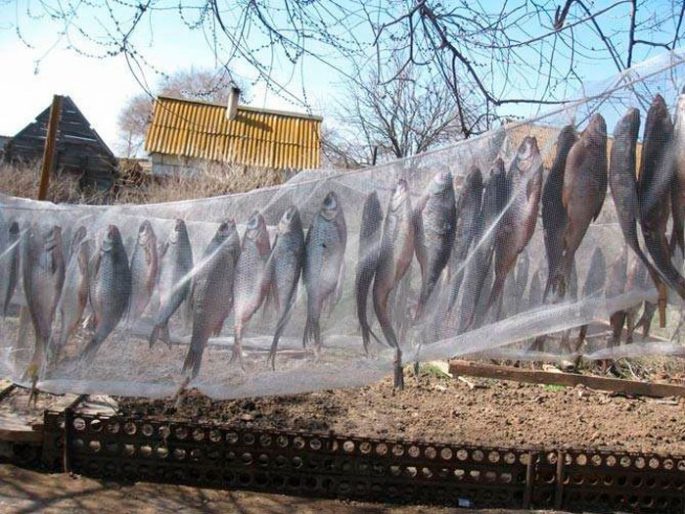
Fish dried outdoors attracts many insects with its aroma, especially wasps and flies. Wasps mainly feed on fish meat, but flies not only eat, but also strive to leave their eggs in the fish meat, after which its larvae appear – maggots.
Without problems, you can dry the fish in the spring, when there are no insects yet, or in the fall, when they are no longer there. In the summer, it is better to start drying in the evening, then the fish dries up overnight, but there are practically no insects in the dark that would be interested in fish. It is not so easy to escape from flies or wasps, although the place where the fish is dried can be hung with a fine mesh, grease the surface of the fish with oil or a weak solution of vinegar. Many simply cook fish outdoors after drying it indoors.
How to dry fish in winter?
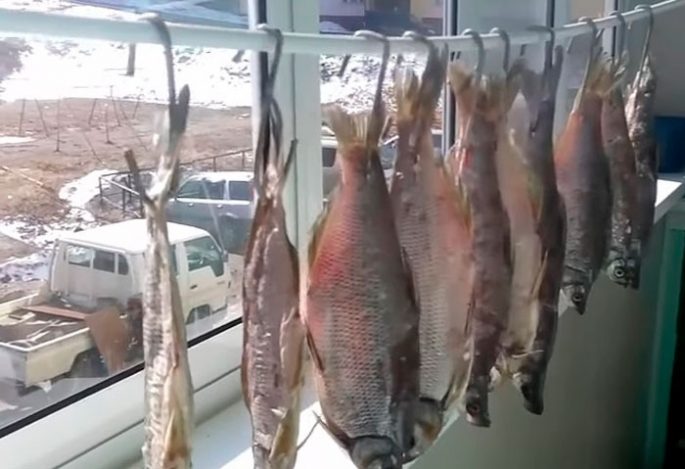
The process of drying fish in winter is somewhat different, since it has to be dried indoors, and this greatly affects the proper maturation of meat. Due to the fact that it is too warm in a person’s home in winter, the processes are accelerated, and the meat does not have time to acquire all the positive qualities.
Winter drying of fish has one positive point: there are no insects in winter, but it is unlikely that you can get rid of its aroma.
On a note! If the fish is dried in winter, then it is better to use the dry salting method to get rid of excess moisture.
The fish is hung mainly in the kitchen under the ceiling or next to the radiator, as well as above the stove. Naturally, it is unlikely that a lot of fish will be dried in residential premises in winter.
Is it possible to dry fish in the cold?
It is desirable that the temperature be above zero, since tissues are damaged at sub-zero temperatures.
On a note! Everyone knows that the process of removing moisture also occurs at sub-zero temperatures.
If you place a winter catch on a balcony or under a canopy, then the fish, although slowly, will dry out, while it will have to be dried indoors.
Useful Tips
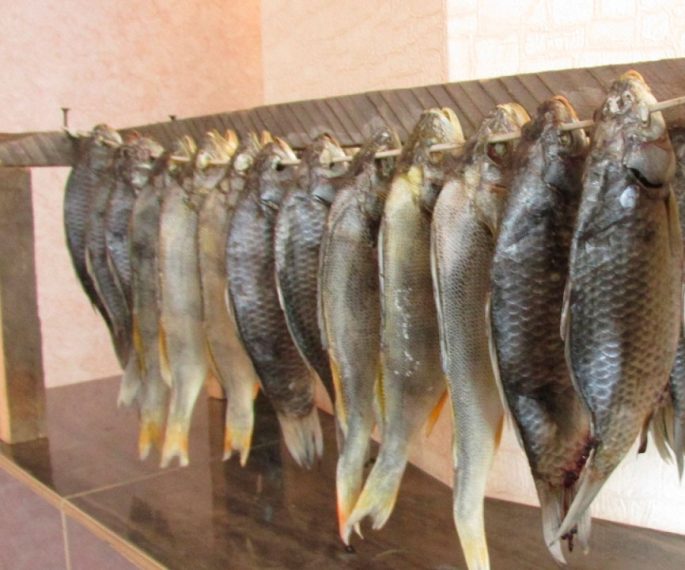
It is permissible to simplify the technology of drying fish, but the efficiency of the process will not suffer from this.
And so:
- When salting fish, large carcasses are placed on the bottom of the tank, and small fish are laid out on top of large ones.
- It is better to string fish of the same size on one rope.
- The bellies are opened with the help of inserted toothpicks, which significantly speeds up the process.
- If you make a special box-frame, then the fish can be easily moved to the right place at any time.
- With the help of this technology, it is permissible to obtain salmon from large fish.
- In case of violation of the storage regime, when the fish absorbs moisture and develops an unpleasant odor, the fish can be washed in salt water and dried.
Drying fish is not difficult, but this technology is quite effective, allowing you to get a tasty and healthy food product for humans.
How to dry fish properly. How delicious to wither roach. The easiest way










